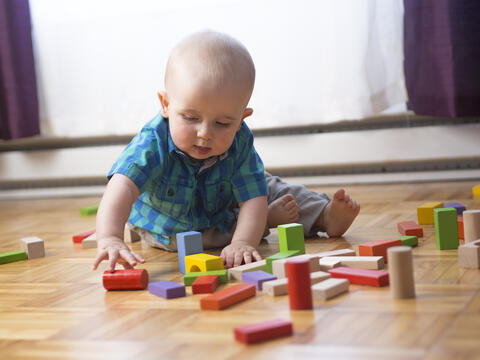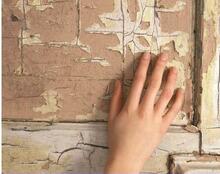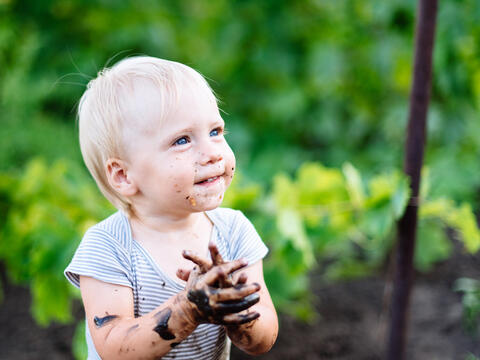Lead-Safe Wisconsin: What is Lead Poisoning?
Childhood lead poisoning
Lead poisoning is a serious health issue that can cause lifelong harm. This is especially true for young children. Even small amounts of lead can affect a child's development, learning, and behavior.
Every year, thousands of Wisconsin children are poisoned by lead. Most often, it's from paint in homes built before 1978.
On this page:
- About Lead (Pb).in our surroundings
- What happens when a child is exposed to lead
- How do Children Get Poisoned?
- Key Risk Factors for Lead Poisoning.
- What Parents and Caregivers Can Do.
- More Resources.
About lead (Pb) in our surroundings
Lead is a toxic metal.
Until recently, companies used lead in paint, plumbing materials, gasoline, and household products. The United States now bans or limits lead in these products, but lead is still around us.
Lead can be in the old paint, dust, pipes, and soil in or around older homes and buildings.
Products like toys, pottery, and makeup from other countries can also contain lead.
To learn more, visit Sources of Lead.
What happens when a child is exposed to lead
With every exposure, lead can build up in our blood, bones, and soft tissue. As lead builds up in the body, symptoms of lead exposure can appear. These include:
- Lower IQ and learning difficulties.
- Trouble with attention, behavior, and impulse control.
- Delayed speech and language skills.
- Slowed physical growth and hearing issues.
- Increased risk of chronic health problems in adulthood.
These effects may not show up right away. A child with lead poisoning may appear healthy. This is why testing is so important.
To learn more about lead testing, visit: Test Your Child for Lead.
What we know from studies and research
Because lead can build up over time, every exposure is dangerous. There is no safe level of lead in the body.
Decades of research have confirmed that even low childhood blood lead levels can cause lasting or lifelong problems. Research shows that lead exposure can cause:
Studies show that lead poisoning can cause academic setbacks, including:
- Lower math and reading test scores
- Lower overall test scores
Increased risks include:
- Anxiety and depression
ADHD
- Antisocial and risky behavior
Lead exposures in childhood can cause problems for the rest of a person's life. Studies link childhood exposure to:
- Higher chance of incarceration
- Higher chance of heart disease and stroke
- Risky pregnancy
- Other health impacts
Wisconsin's definition of lead poisoning
A blood test is the only way to know if your child has been exposed to lead.
Blood lead testing measures lead levels in terms of micrograms of lead per deciliter of blood, or micrograms per deciliter (ug/dL).
Although there is no safe level of lead in the blood, public health workers need a way to identify children that have the highest risk for health problems from lead exposure. To do this, the Wisconsin Department of Health Services (DHS) sets a definition of lead poisoning to help public health workers use their resources most effectively.
In 2021, the CDC (Centers for Disease Control and Prevention) updated the blood lead reference value to 3.5 micrograms per deciliter (ug/dL). This blood lead value is higher than 97.5% of children nationwide.
In February 2025, Wisconsin approved an emergency rule to match this response value. Within its first year, this new response value will impact over a thousand Wisconsin children.
By using this reference value, workers can confidently identify and support children who are at the greatest risk for lifelong health problems.
To learn more about the how public health workers respond to different blood lead levels, visit: Get Your Child Tested for Lead.
How do children get lead poisoned?
Most children encounter lead in their own homes or in places that they visit regularly. Exposure to lead usually happens by swallowing or breathing it in.
-
Swallowing lead paint, dust, or soil
Children often put their hands or toys in their mouths. If their hands or toys had lead dust on them, the child could swallow that dust.
Breathing in lead dust
When lead dust becomes airborne, children can breathe it in. This is very common during home renovations or repairs.
Eating or drinking contaminated items
Consuming lead is very dangerous. Look out for lead in products from other countries, deer shot with lead bullets, water from old pipes, or food kept in lead-glazed pottery.
Key risk factors
Lead is dangerous for all children, but some children are more at-risk. Families can take actions against lead poisoning by understanding common risk factors.
Age
Children under age 6 are especially at risk for becoming lead poisoned. At this stage, kids crawl on the floor and put their hands in their mouths. They are also still developing. Their brains are more sensitive to harm, and their bodies absorb more lead than adults.
To learn more, visit: Test Your Child for Lead.
Old housing and buildings
Homes and buildings built before 1978 are more likely to contain lead-based paint or shellac. Use caution around peeling or chipping paint, old windows, and any renovation projects.
Worn out, unmaintained housing can also pose a risk to children. Because of this, children in poverty or low-income areas are often at a higher risk for lead poisoning.
To learn more, visit: Make Your Home Lead-Safe.
Parent/guardian jobs and hobbies
If a parent or caregiver works with lead, they can exposure their child if it is on their skin, shoes, or clothing. Risky jobs and hobbies include construction, hunting, painting, battery manufacturing, and auto repair.
To learn more, visit: Sources of Lead.
Pregnancy and lactation
If a person has too much lead in their body when pregnant, it can expose the child to the same risks as lead dust. Breast milk can also contain elevated lead levels.
To learn more, visit: Lead Safety During Pregnancy and Lactation
What parents and caregivers can do
If you're a parent or caregiver of a young child, you can take action. There are steps you can take right now to reduce the risk of lead exposure and catch it early if it does occur.
1. Get your child tested
A blood test is the only way to know if your child has been exposed to lead. Most children with lead poisoning don't look or act sick.
- All children should be tested at 12 and 24 months of age (age 1 and age 2).
- Children between ages 3 and 5 should also receive a blood test if they have not been tested before.
Testing is covered by Medicaid and most insurance plans. Talk to your doctor or local health department to schedule a test or find resources.
Learn more about getting your child tested
2. Test and maintain your home
If your home was built before 1978, it may contain lead hazards. Testing and maintaining your home helps keep lead out of your child's surroundings.
Use good cleaning practices.
Test painted surfaces, dust, soil, and water for lead.
Hire a certified professional if you're planning renovations.
3. Practice everyday prevention
Simple daily habits can go a long way in prevention exposure:
- Wash your hands and toys often, especially before meals and after playing outside.
- Use only cold water for cooking, drinking, or mixing infant formula.
- Take shoes off at the door to keep soil and dust out.
- Stop children from chewing on painted windowsills or furniture.
- Use disposable wet wipes to clean floors and windowsills. Never sweep or vacuum lead dust.
For more information, visit: Make Your Home Lead Safe.




